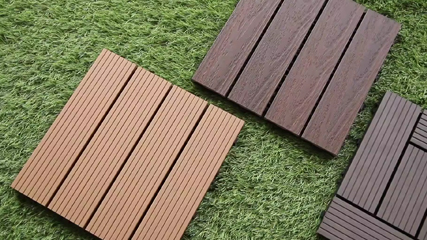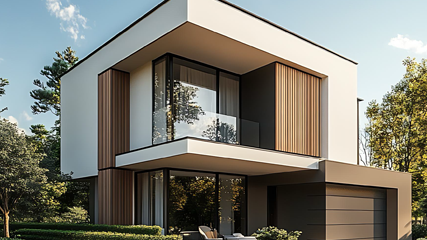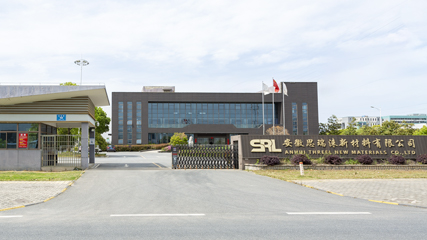When choosing between WPC (Wood Plastic Composite) and PVC (Polyvinyl Chloride) fencing, it’s important to weigh a number of factors such as longevity, aesthetics, cost, maintenance, environmental impact, and overall performance. Here’s a detailed breakdown to help you understand the pros and cons of both materials and make an informed decision.
1. Understanding WPC and PVC Fencing
WPC Fencing
WPC is a blend of wood fibers and plastic (usually polyethylene), offering the appearance of wood while benefiting from plastic’s durability and low maintenance. It’s a popular choice for those who want the rustic look of timber but without the drawbacks that natural wood often presents (e.g., rotting, splintering).
PVC Fencing
PVC, or vinyl fencing, is made from high-density plastic polymer. It's known for being durable, lightweight, and resistant to many of the issues that affect traditional wooden fences (e.g., insect damage, rot, and weathering).
2. Durability and Maintenance
WPC Durability
Weather Resistance: WPC is generally very durable against extreme weather conditions, including rain, snow, and heat. However, extreme humidity may cause wood fibers to swell, leading to a slight degradation in appearance over time.
Maintenance: It requires periodic cleaning but is generally lower maintenance than wood. It is more resistant to pests like termites, which can be a major issue for natural wood.
Lifespan: WPC fences can last between 15 to 25 years with proper care, depending on the environmental conditions.
PVC Durability
Weather Resistance: PVC is highly resistant to UV rays, moisture, and salt, making it a great choice for coastal areas. Unlike wood, it does not warp or crack under the sun’s harsh rays.
Maintenance: PVC is incredibly low-maintenance. It does not need to be painted or sealed, and a simple wash with soap and water typically suffices for cleaning.
Lifespan: PVC fences can last upwards of 30 years, with little to no degradation over time.

3. Aesthetics and Design Flexibility
WPC Aesthetics
Wood-Like Appearance: WPC fences provide a natural, wood-like aesthetic that many homeowners find appealing. It can mimic the grain and texture of natural wood, offering the rustic charm of timber without the drawbacks.
Customization: WPC fences come in a range of styles, colors, and finishes. You can find designs that resemble traditional picket fences, modern privacy fences, or even horizontal slat designs.
PVC Aesthetics
Clean and Modern Look: PVC fences typically have a smooth, clean, and uniform appearance. While this appeals to those seeking a more modern and streamlined look, it may not replicate the natural texture and warmth of wood.
Color Range: PVC is available in a range of solid colors, with white being the most common. Some manufacturers offer wood grain textures, but these are not as convincing as WPC.
4. Cost Considerations
WPC Fencing Cost
Initial Cost: WPC fences tend to have a higher initial cost than traditional wood fences, but they are often less expensive than PVC.
Long-Term Value: Despite a higher upfront cost, WPC fences may save money in the long run due to their durability and reduced maintenance needs.
PVC Fencing Cost
Initial Cost: PVC fences are generally more expensive than wood and WPC fences, especially if you opt for high-end designs or customizations.
Long-Term Value: PVC is a great option for those who want to avoid ongoing maintenance costs, as it’s one of the lowest-maintenance fencing options available.
5. Environmental Impact
WPC Environmental Considerations
Sustainability: WPC is considered more eco-friendly than traditional plastic fencing because it’s made from recycled wood fibers and plastic. However, its environmental impact can vary depending on the exact materials used and the production process.
Recyclability: While WPC is more sustainable than pure plastic, it may not be as easily recyclable as some other materials.
PVC Environmental Considerations
Sustainability: PVC is not considered eco-friendly. It is made from petroleum-based plastic, and its production can release harmful chemicals into the environment. Recycling options for PVC are also limited.
Recyclability: While PVC is technically recyclable, the process is complicated, and it is not widely accepted in recycling programs.
6. Installation
WPC Fence Installation
Ease of Installation: WPC is relatively easy to install, especially with pre-fabricated panels. However, it may require some expertise if you're creating custom designs.
Weight: WPC fences can be heavier than PVC, so installation may require extra hands or specialized equipment, particularly for large sections.
PVC Fence Installation
Ease of Installation: PVC fencing is generally lightweight, making it easier to handle and install compared to WPC. It is often sold as pre-assembled panels, reducing the time and labor involved in installation.
DIY-Friendly: Many homeowners opt for DIY installation with PVC, as it’s simple to assemble and install with basic tools.
7. Conclusion: Which is Better?
Choosing between WPC and PVC fencing depends on your priorities:
For a natural wood appearance: WPC is the better option. It offers the best of both worlds — the beauty of wood with the durability of plastic.
For low maintenance and longevity: PVC takes the lead. Its virtually maintenance-free nature and extended lifespan make it ideal for those looking for a “set it and forget it” fencing solution.
For environmental concerns: WPC might be a more sustainable option since it’s made from recycled materials, though PVC can last longer with fewer environmental impacts in terms of maintenance.



























